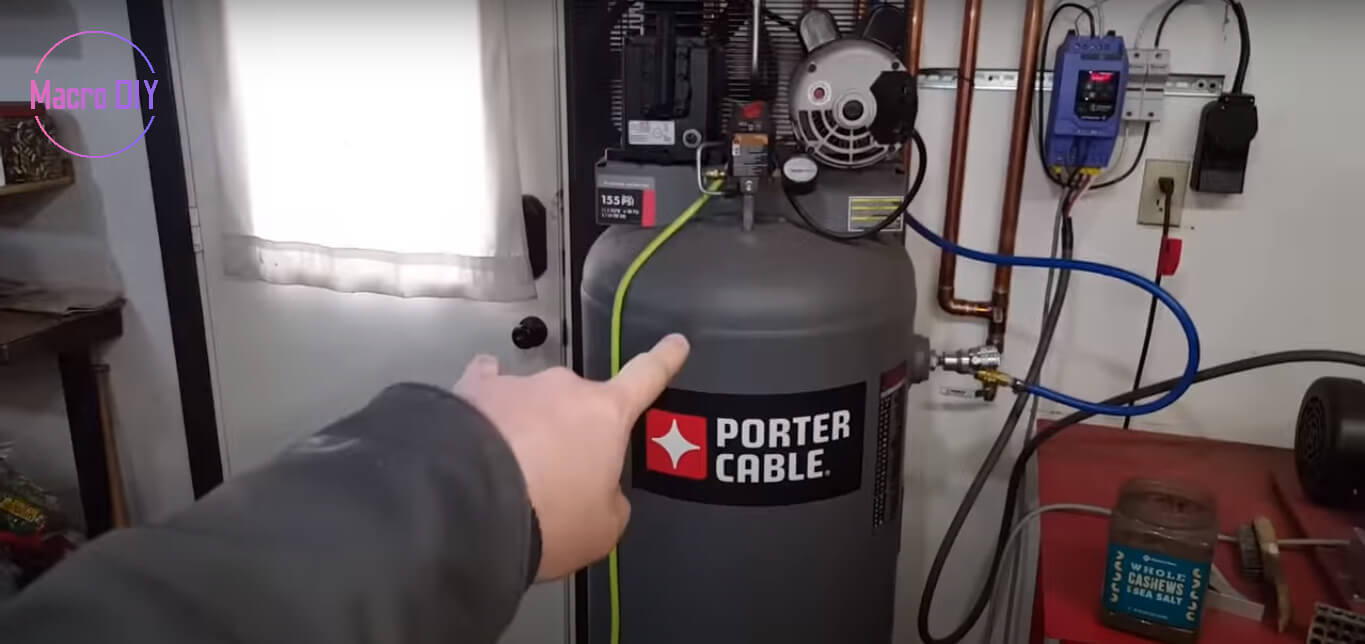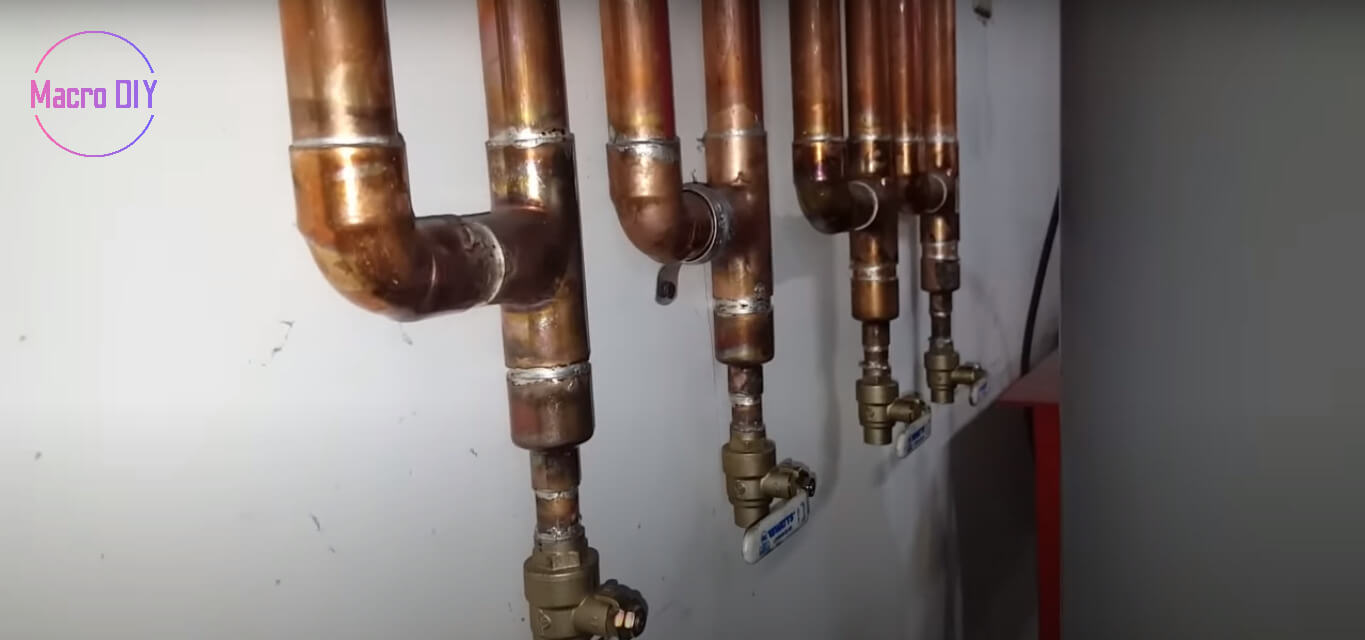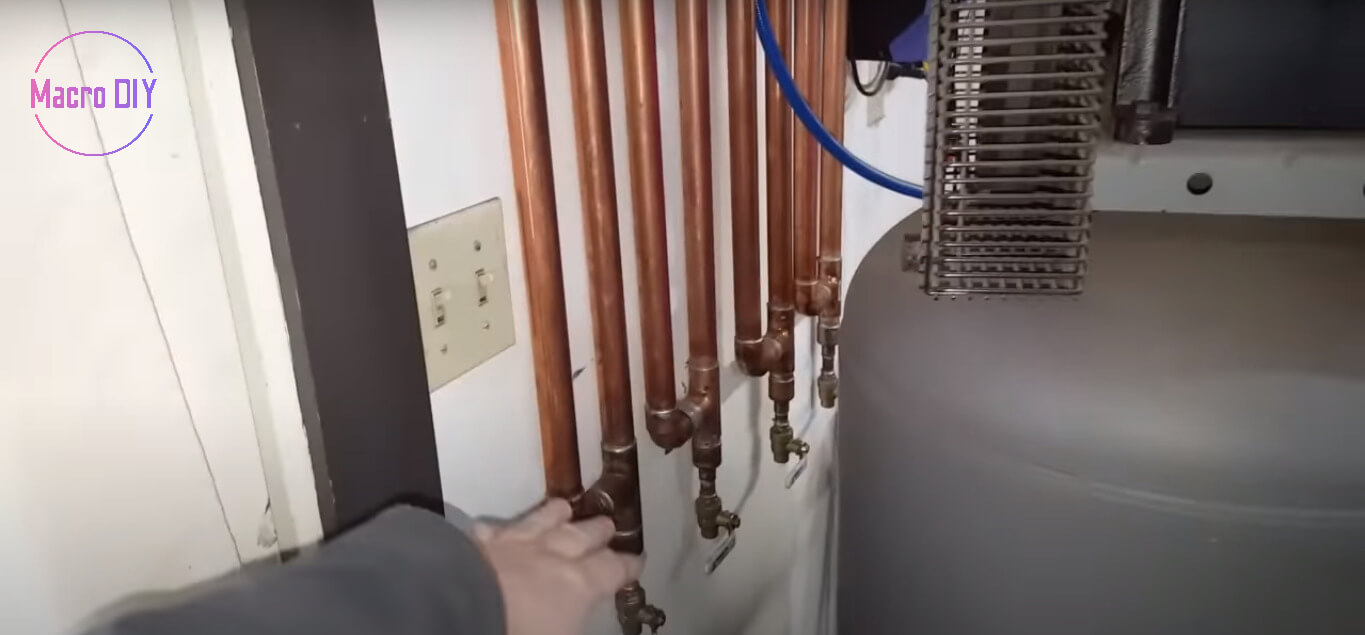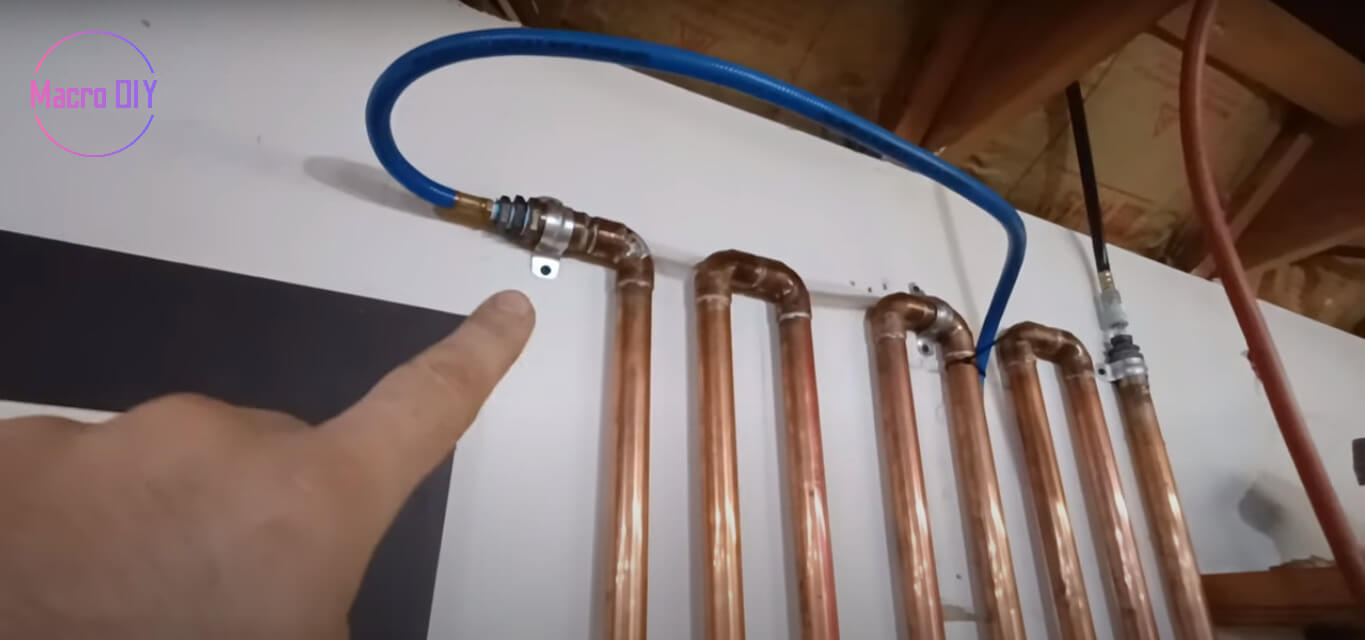Embark on a DIY compressed air dryer guide with Richard Beck! Navigate skepticism, trial, and triumph to attain pristine shop air. Uncover thermal transfer nuances, large tubing prowess, and moisture parting wisdom. Explore viewer insights, electric valve ingenuity, and maintenance hacks for workshop air nirvana at Beck’s Armory – the convergence of DIY innovation and mastery!
Let’s dive into the checklist of items and tools you’ll need to embark on this epic journey of crafting your own compressed air dryer:
- Tubing Galore: Go big or go home! Opt for 1-inch tubing for maximum surface area and moisture separation efficiency. Richard swears by it, and who are we to argue?
- Valve Extravaganza: Secure those shutoff valves for controlled bursts of air release. Consider those little knobs—easy control is the name of the game.
- Water Separators: Follow Richard’s footsteps and invest in quality water separators and fine mist separators. SMC seems to be the go-to for moisture-free air.
- T-fittings and Reducers: Strategically position your T-fittings to induce turbulence and create a drop zone for moisture. And don’t forget those reducers for seamless transitions.
- Soldering Arsenal: Equip yourself with soldering skills and gear. Richard insists on soldering for robust joints, ensuring no leaks or mishaps.
- A Compressor to Rule Them All: Richard sings praises for his Porter Cable model, and why not? It’s a 60-gallon powerhouse, delivering 150 psi of compressed air goodness.
- Space Considerations: If your shop allows, create a gap behind the setup for increased airflow. Richard’s tip: four inches for that perfect sweet spot.
- Electric Valve & Timer (Optional): For the tech enthusiasts, an electric valve with a timer could automate the draining process. Convenience at its finest.
- Copper, Not PVC: Don’t even think about PVC. Richard’s thermal coefficient lesson emphasizes copper’s superiority. PVC is a waste of your hard-earned money.
- Galvanized vs. Copper Fittings: Richard’s galvanized fittings haven’t betrayed him yet, but some caution against potential corrosion. Copper or plastic alternatives might be worth exploring.
Other technical specifications:
- PVC = 0.17 W/m K
- Steel = 43 W/m K
- Copper = 413 W/m K
Contents
- Crafting Clean and Dry Shop Air: Unveiling the DIY Revolution
- Unveiling the DIY Compressed Air Dryer Setup: Where Innovation Meets Mastery
- Unveiling Mastery: Testing and Demonstrating the DIY Compressed Air Dryer’s Effectiveness
- Unleashing Ingenuity: Additional Enhancements and Viewer Suggestions
- Sustaining Brilliance: Long-Term Usage and Maintenance Revelations
- FAQs about DIY Compressed Air Dryer
- Unveiling Brilliance: A Game-Changing DIY Compressed Air Dryer
Crafting Clean and Dry Shop Air: Unveiling the DIY Revolution
Salutations, fellow DIY enthusiasts! Ready your tool belts and brace yourselves for an exhilarating journey into the heart of shop air purification. I’m Richard Beck, your guide through the labyrinth of achieving pristine, moisture-free air in your workshop. Today, we embark on a quest to revolutionize your DIY compressed air dryer experience.
Delving into Doubt: A Skeptic’s Odyssey
Now, let’s rewind the tape a bit. Picture this: a cluttered shop, tools scattered like confetti after a jubilant celebration of craftsmanship. Amidst this chaos, I stumbled upon an idea – a DIY compressed air dryer. But hold on, skepticism loomed like a dark cloud over my enthusiasm.
Can conventional DIY dryers truly stand up to the challenge, or are they just a mirage of false promises? The YouTube realm overflowed with tales of success, yet doubts crept in. Would these setups withstand the rigors of my bustling workshop? The answer wasn’t as crystal clear as the air we aimed to achieve.
Enter the conundrum of velocity control, a puzzle that baffled my inquisitive mind. The prevailing concern: would the sheer force of air, intended to liberate moisture, inadvertently become a culprit in dragging it along? A potential boomerang effect that could sabotage the very dryness I sought to achieve.
The science was sound – cool the air, separate the moisture, and witness the magic of condensation. Yet, the execution demanded finesse. Quarter-inch or half-inch tubing, the standard choices, left me pondering. And then, a light bulb moment – why not break free from the norm? One-inch tubing emerged as my unconventional weapon of choice, promising enhanced performance beyond my wildest imagination.
Read more: DIY electric fireplace with mantel
Richard’s Tubular Symphony: An Ode to One-Inch Mastery
Ladies and gentlemen, here’s where the plot thickens. Enter one-inch tubing, my secret sauce for unparalleled efficiency. The naysayers may question the logic – is bigger truly better? Brace yourselves for a revelation – yes, it is! The larger tubing, a conduit of pure prowess, surpassed my expectations, unlocking levels of moisture removal that bordered on the mystical.
A stroll through my shop, armed with this one-inch marvel, revealed a world where moisture dared not linger. The air slowed down, gracefully dancing through the tubes, leaving behind the unwanted baggage of moisture. And thus, a DIY masterpiece was born.
In the realm of DIY compressed air dryers, it’s not just about functionality; it’s about pushing the boundaries. Picture this – a world where moisture is not just an inconvenience but an ancient memory. One-inch tubing – the unsung hero of the air purification saga.
Now, my intrepid comrades, the stage is set, the curtain rises. But fret not; the plot thickens further. Join me in the next act as we put this DIY air-drying symphony to the test, unveiling the magic through the lens of practicality.
Unveiling the DIY Compressed Air Dryer Setup: Where Innovation Meets Mastery

Greetings, fellow artisans of the workshop! As we delve deeper into the realm of DIY compressed air dryers, we find ourselves at the crux of innovation – the setup. Brace yourselves, for in this chapter, the secrets of my workshop’s beating heart are laid bare.
The One-Inch Marvel: Tubing Size Consideration
Why settle for the ordinary when the extraordinary beckons? One-inch tubing, the unsung hero of our narrative, takes center stage. Imagine a world where air flows not just efficiently but majestically. The size does matter, my friends, and in this case, bigger is undeniably better.
This isn’t a mere choice; it’s a proclamation of intent. One-inch tubing stands as a testament to breaking free from the conventional shackles that bind DIY enthusiasts. With every inch, it champions optimal performance, promising a symphony of air purification that resonates through the very essence of your workshop.
Components Unveiled: Shut-off Valves, Water Separators, and Fine Mist Separators
Now, let’s open the treasure trove and acquaint ourselves with the maestros orchestrating this air-purifying ballet. Enter the shut-off valves – the unsung conductors, allowing for meticulous control over the airflow. Picture this: a workshop where the air bends to your will, stopping when and where you desire.
But that’s not all – the water separators and fine mist separators add layers to our symphony. Imagine them as the vigilant gatekeepers, ensuring that not a droplet of moisture infiltrates the sanctum of your compressed air. These components, meticulously selected and strategically placed, transform your workshop into a haven of dry, pristine air.
Embracing Grandeur: The Significance of Large Tubing
Why settle for mediocrity when grandeur beckons? Large tubing, with its expansive surface area, emerges as the unsung hero in our odyssey. It’s not just about moving air; it’s about conducting a symphony. The larger tubes gracefully dance with the airflow, reducing velocity and allowing moisture to cascade down like a gentle waterfall.
As your workshop breathes through these expansive conduits, the benefits unfold – efficient moisture separation, reduced turbulence, and a harmonious marriage of airflow and surface area. The result? A setup that transcends the ordinary, beckoning you into the realm of DIY excellence.
A Month in Wonderland: Richard’s Real-world Experience
Now, let me whisk you away to a real-world tale – my own odyssey with the DIY compressed air dryer setup. Picture this: a month of relentless crafting, a cacophony of tools at play, and the one-inch tubing holding its ground. The verdict? A resounding success.
No moisture dared to linger; the shut-off valves orchestrated their ballet, and the separators stood guard against the intrusion of unwanted droplets. As the workshop echoed with the hum of creativity, the air remained crisp and dry. A testament to the prowess of this DIY setup.
Read more: Trash bag dispenser DIY
Now, my dearest companions, the stage is set, the components are in place. But fear not, for our journey into DIY compressed air dryers has just begun. Join me in the next act, where we dive into the intricacies of the system’s functionality, unraveling the mysteries that make it a true masterpiece.
Unveiling Mastery: Testing and Demonstrating the DIY Compressed Air Dryer’s Effectiveness

Greetings, fellow architects of the workshop symphony! As our odyssey through the realm of DIY compressed air dryers continues, we find ourselves standing at the precipice of revelation. In this act, we pull back the curtain, revealing the intricate dance of testing and demonstrating the unparalleled effectiveness of our creation.
The Alchemy of Testing: Richard’s Ritual Unveiled
Enter the workshop laboratory, a realm where air quality becomes an art form. Richard, our maestro, orchestrates a meticulous testing procedure, a ritual of precision that separates the mundane from the extraordinary. Picture this – gauges whispering secrets, instruments humming in anticipation, and the DIY compressed air dryer standing ready for scrutiny.
This is no ordinary test; it’s a symphony of data collection. Richard, armed with knowledge and experience, meticulously observes the airflow dynamics, ensuring that every nuance is captured. The air becomes a canvas, and the testing procedure paints a vivid picture of the system’s prowess.
The High-Pressure Ballet: Impact on Moisture Removal
As we delve deeper, the stage transforms into an arena for a high-pressure ballet. Witness the raw power of air, elevated to new heights. Richard, with the flair of a magician, introduces high-pressure air into the equation. The result? A spectacle where moisture bows in submission, forced to exit the stage.
Imagine a torrent of air, surging through the system, leaving no room for moisture to linger. This high-pressure dance is not just a test; it’s a declaration of dominance. The DIY compressed air dryer, with its one-inch tubing and strategic components, emerges victorious, leaving the workshop air pristine and untouched by the lingering embrace of moisture.
Unveiling Moisture Reduction Insights
In the aftermath of the high-pressure performance, let’s peer into the depths of moisture reduction insights. Richard, our guide through this labyrinth, compares moisture levels at different stages of the system. It’s not just about removing moisture; it’s about achieving a delicate balance, ensuring that the air remains dry without compromising efficiency.
Picture the journey – from the entry point of air to its exit, each component contributing to the symphony of moisture reduction. Richard’s insights unravel the mysteries, providing a roadmap for enthusiasts seeking not just dry air but perfection in every breath their workshop takes.
Richard’s Pearls of Wisdom: Practical Tips for Optimal Performance
As the curtain begins to fall on this act, Richard steps forward, sharing his pearls of wisdom – practical tips for optimal performance during the testing phase. This is not a mere list; it’s a collection of secrets garnered through years of mastery. From fine-tuning shut-off valves to understanding the nuanced dance of separators, these tips elevate your DIY compressed air dryer experience.
And with that, dear companions, we conclude this revelatory act. But fret not, for the crescendo continues in the next chapter, where we embark on a journey through the real-world applications of our DIY masterpiece. Join me as we breathe life into the workshop, one dry and crisp breath at a time.
Unleashing Ingenuity: Additional Enhancements and Viewer Suggestions

Ah, dear comrades of the workshop, welcome to the crescendo of our DIY symphony! In this act, we delve into the realm of viewer engagement, where suggestions and feedback morph into the building blocks of innovation. Fasten your seatbelts as we embark on a journey through the minds of our fellow architects and explore additional enhancements suggested over eight months.
Viewer Engagement: An Ode to Collaborative Mastery
Imagine the workshop as a grand amphitheater, echoes of suggestions reverberating within its walls. Our revered viewers, the unsung heroes of this DIY saga, have spoken, and we’ve listened with bated breath. From the subtle nuances of air dynamics to the grandeur of system improvements, their insights have shaped the evolution of our DIY compressed air dryer.
We tip our hats to the community, acknowledging the diverse tapestry of suggestions that have woven themselves into the fabric of our creation. Each comment, a brushstroke on the canvas of ingenuity, has contributed to the refinement of our masterpiece.
Read more: Patio roof extension ideas
PVC Alternatives: Richard’s Wisdom Unveiled
As we tread further, let’s explore the labyrinth of PVC alternatives. Richard, our guide through the DIY cosmos, shares his perspective on the utilization of PVC and the intricate dance of thermal transfer considerations. Picture the workshop as a cauldron of experimentation, where choices aren’t arbitrary but a symphony of calculated decisions.
Richard’s insights peel back the layers, revealing the reasoning behind material choices and their impact on the thermal dynamics of our DIY compressed air dryer. It’s not just about function; it’s about understanding the poetry of materials and their harmonious dance in the workshop ecosystem.
Addressing Corrosion Concerns: Galvanized Steel and Beyond
Corrosion, the silent nemesis of any DIY enthusiast, takes center stage in our discourse. We address the perennial concern by delving into the choice of galvanized steel fittings and potential alternatives. Richard’s wisdom becomes a beacon, guiding us through the maze of corrosion prevention.
Visualize the workshop as a battleground, where galvanized steel stands as a stalwart defender against the relentless forces of decay. Yet, we explore the landscape, considering alternative guardians that may stand shoulder to shoulder in the fight against corrosion. Choices unfold like chapters in a riveting novel, each revealing a facet of the ongoing saga.
Innovative Ideas: Electric Valves and Automatic Moisture Release
Ah, the pièce de résistance – innovative ideas that shimmer like stars in the workshop sky. Viewer suggestions, whispered like secrets shared among confidants, introduce us to the realm of electric valves for automatic moisture release. The workshop metamorphoses into a futuristic arena where automation meets craftsmanship.
Marvel at the ingenuity of our community, where suggestions transcend the ordinary and propel our DIY compressed air dryer into uncharted territory. The electric valves, a stroke of brilliance, become the catalyst for a moisture-release ballet, choreographed by the pulse of technology.
As the curtain falls on this act, our journey through the ever-expanding cosmos of DIY mastery continues. Stay tuned, dear companions, for the grand finale awaits, where we unveil the culmination of wisdom, innovation, and the relentless pursuit of perfection.
Sustaining Brilliance: Long-Term Usage and Maintenance Revelations

Welcome, cherished companions, to the penultimate chapter of our DIY odyssey. As we navigate the terrain of long-term usage and maintenance, the spotlight shifts to Richard’s seven-month saga, unveiling the hidden nuances of relentless operation and the meticulous care required for sustained brilliance.
Extended Usage Experience: Richard’s Seven-Month Chronicle
Picture the workshop as a time capsule, encapsulating seven months of unyielding operation. Richard, our maestro of experimentation, shares his firsthand account of the DIY compressed air dryer’s journey through the sands of time.
The narrative unfolds like a tale of resilience, chronicling the system’s performance under the duress of continuous use. Dive into the intricacies of wear and tear, the symphony of components harmonizing in the background, and the wisdom garnered from a prolonged dance with compressed air dynamics.
Valve Maintenance: The Guardian’s Vigilance
In the heart of our DIY opera lies a crucial act – the maintenance of the unsung heroes, the shut-off valves. Imagine them as sentinels guarding the gateway to dry and pristine air. Richard’s voice, a whisper in the workshop breeze, emphasizes the paramount importance of regularly checking and maintaining these vigilant custodians.
Visualize the valves as gatekeepers ensuring the sanctity of the system. Richard’s insights become the guiding light, illuminating the path to sustained excellence. This section becomes a masterclass in valve care, a ritualistic dance of inspection and nurturing that ensures the longevity of our DIY creation.
Read more: DIY under stair storage
Potential Improvements: Electric Valves on the Horizon
As we tread further into the realms of possibility, electric valves emerge as a beacon of convenience. The workshop, once a realm of manual operation, flirts with the idea of automation. Richard’s contemplation on incorporating electric valves introduces a new dimension to our DIY symphony.
Feel the pulse of innovation as we explore the landscape of potential improvements. The prospect of automation not only elevates the user experience but also stands as a testament to our unwavering commitment to pushing the boundaries of DIY excellence.
Additional Considerations: Spacing for Flow, Performance, and Harmony
In the grand tapestry of DIY mastery, every detail matters. This section unravels the subtle art of spacing – a choreography that enhances airflow, augments performance, and orchestrates harmony within the workshop. Richard’s tips become the choreographer’s notes, guiding enthusiasts through the spatial ballet that transforms functionality into artistry.
Visualize the workshop as a stage where the positioning of components becomes a dance of balance. Richard’s recommendations transcend the mundane, turning the setup into a work of spatial artistry that not only breathes life into the system but also elevates its overall performance.
As the curtains draw close on this act, we stand at the precipice of our grand finale. Join us, dear companions, as we unveil the crescendo of DIY brilliance, where Richard’s wisdom and the collective ingenuity of our community converge into a masterpiece of mechanical artistry.
FAQs about DIY Compressed Air Dryer

Whoa, buckle up for a rollercoaster of DIY wisdom with Richard Beck! Today, he’s diving deep into the mysteries of shop air and how to keep it clean and dry. I mean, who knew shop air could be so complex, right? So, let’s unpack the FAQs about DIY compressed air dryers from the master himself.
Can I use PVC for my compressed air dryer?
Richard emphatically advises against it. He throws up some coefficients of thermal transfer on the screen (yes, coefficients! Get ready for some science), comparing PVC, copper, and steel. PVC seems to be the unpopular kid at the thermal transfer party.
Why Copper, not Steel or Plastic?
Richard breaks it down with coefficients again (mind-blowing stuff, I know). It turns out, copper’s thermal transfer is the belle of the ball, ensuring optimal performance for your DIY air-drying extravaganza.
Electric Valve for Auto-Dumping?
Ah, the future is here! Some genius suggested auto-dumping with an electric valve and a timer. Richard’s all in favor and even drops an Amazon link for your shopping pleasure.
Galvanic Corrosion – Copper vs. Galvanized Steel?
You’d think copper and steel would throw punches, but Richard’s galvanized steel fittings seem to be holding up just fine. Maybe they’re sharing shop air secrets.
Size Matters?
Richard introduces the concept of a large manifold, uniting all four valves into one. The key? High flow for that thunderous burst of air when you crack those valves open.
Airflow Optimization – Spacing and Fans?
Oh, you thought air drying was just about tubes? Think again! Richard’s fans of spacing out the pipes, allowing the compressor’s suction to create an airflow spectacle. Mind = blown.
DIY Air Dryer vs. Moisture Madness?
Richard reminisces about the moisture tsunami from his previous video, showcasing the sheer power of his DIY air-drying masterpiece. Spoiler alert: it works like a charm.
Unveiling Brilliance: A Game-Changing DIY Compressed Air Dryer
As the curtain descends on our DIY saga, let’s embark on a concise yet exhilarating journey through the crescendo of brilliance that is the DIY compressed air dryer. Brace yourselves, dear companions, for a recap that encapsulates the essence of ingenuity, the heartbeat of our shared DIY odyssey.
Recap of Key Points: The Tapestry of DIY Mastery
Picture the DIY compressed air dryer as a canvas adorned with the strokes of innovation. In this swift recap, we unravel the tapestry, highlighting the key strokes – the choice of one-inch tubing, the ensemble of shut-off valves and separators, the dance of velocity control, and the symphony of large tubing. Each stroke contributes to a masterpiece that transcends conventional wisdom.
Feel the pulse of DIY mastery as we summarize the crucial aspects, echoing the melody of our collective brilliance. Richard’s brainchild, meticulously dissected, becomes a blueprint for enthusiasts worldwide – a testament to the power of community-driven innovation.
Invest in Brilliance
Amidst the complexity lies a call to action, a beckoning to our viewers to invest in this game-changing system. Richard’s voice, a beacon of encouragement, resonates through the digital realm. Imagine his words as a rallying cry, urging enthusiasts to embrace the DIY revolution and witness the transformation in their workshops.
Visualize the workshop landscape evolving, the air becoming a pristine whisper devoid of moisture, and the DIY compressed air dryer standing as a stalwart companion in the pursuit of excellence. Richard’s encouragement becomes a mantra, inviting viewers to join the ranks of those who have harnessed the power of brilliance.
Future Developments: A Glimpse into Beck’s Armory
As we bid adieu to this chapter, a teaser unfolds – a sneak peek into the future developments at Beck’s Armory. The workshop, a cauldron of creativity, hints at exciting projects and equipment additions. Richard, the visionary, invites you to stay tuned, tantalizing the senses with the promise of more DIY marvels.
Envision the workshop as a playground of possibilities, where innovation knows no bounds. Future developments become a whispered secret, an invitation to witness the evolution of DIY brilliance. The journey continues, and with it, the promise of more awe-inspiring revelations.
As we conclude this chapter, let the echoes of DIY brilliance resonate in your workshop, and may the DIY compressed air dryer stand as a symbol of ingenuity, camaraderie, and the relentless pursuit of excellence. Until Macro DIY‘s next DIY odyssey, dear companions, continue to craft, innovate, and revel in the joy of DIY mastery.
Key Takeaways for DIY Compressed Air Dryer:
- Introduction to DIY Compressed Air Dryer:
- Richard Beck shares insights on achieving clean and dry shop air.
- Expresses initial skepticism but dives into the science of cooling air to separate moisture.
- Tube Size Matters:
- Emphasizes using one-inch tubing for better performance.
- Larger tubing allows for slower air velocity, reducing the risk of moisture being pulled along.
- Moisture Removal Demonstration:
- Demonstrates draining moisture from the system by cracking open valves at different points.
- Highlights the effectiveness of the setup in removing moisture even at high pressure.
- Additional Filtration for CNC Plasma Table:
- Introduces water separator and fine mist separator for CNC plasma table use.
- Explains the importance of clean and dry air for optimal CNC plasma table performance.
- Cost and Investment:
- Acknowledges the system’s cost, emphasizing its value for air tool users, painters, and CNC plasma cutter owners.
- Recommends investing in clean and dry air for extended consumable life and better tool performance.
- Equipment and Soldering:
- Showcases the air compressor model and its affordability.
- Highlights the soldering of tubing as a crucial aspect, encouraging viewers to learn the skill.
- User Interaction and Engagement:
- Encourages viewers to give a thumbs up if finding value in the video.
- Asks for subscriptions and shares, fostering a sense of community among DIY enthusiasts.
- Long-Term Performance and Maintenance:
- Shares the system’s performance after a month, indicating minimal moisture in the separators.
- Addresses potential corrosion concerns by using galvanized steel and copper fittings.

